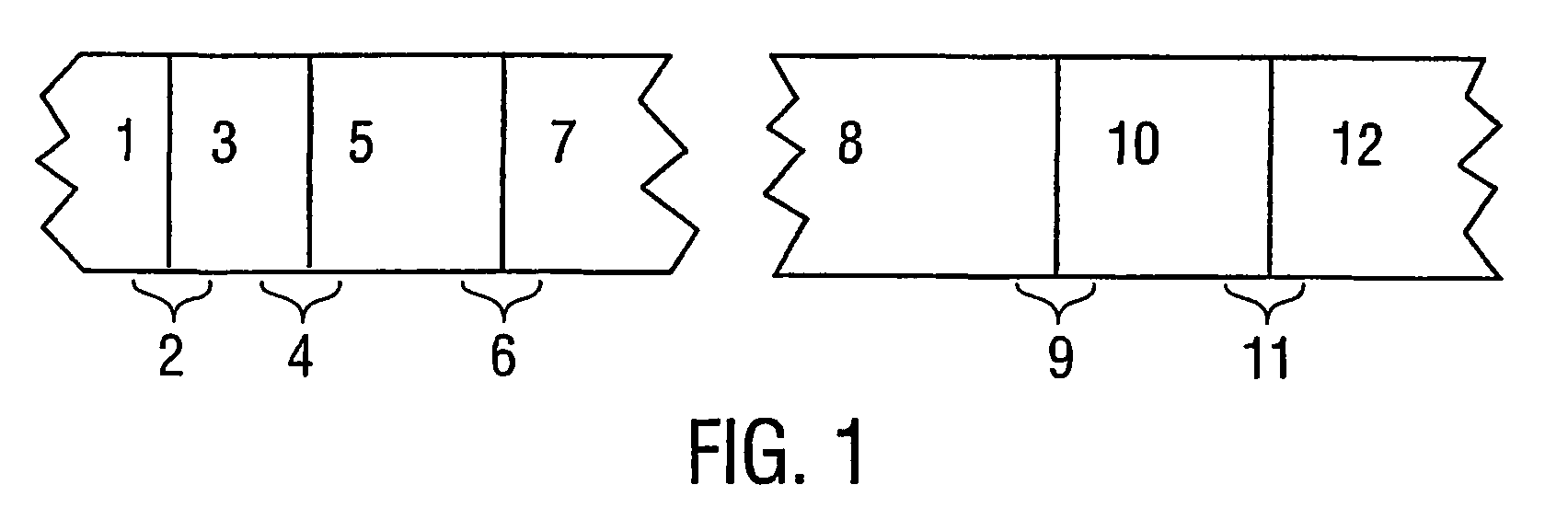Cotton event MON15985 and compositions and methods for detection thereof
a technology of cotton plant and event, applied in the field of plant molecular biology, can solve the problems of inconvenient detection of separate events, cotton plant is susceptible to insect infestation,
- Summary
- Abstract
- Description
- Claims
- Application Information
AI Technical Summary
Benefits of technology
Problems solved by technology
Method used
Image
Examples
example 1
[0039]Cotton, Gossypium hirsutum, has been genetically modified to resist Lepidopteran pests, which have a negative impact on cotton production. This was accomplished as indicated herein by the insertion of a DNA cassette which encodes the insecticidal Cry1Ac protein from Bacillus thuringiensis into the genome of cotton cultivar Coker 312 through Agrobacterium sp transformation using a DNA fragment derived from plasmid PV-GHBK04 (pMON10518 in U.S. Pat. No. 5,500,365). This transformation resulted in three separate insertions into the cotton genome. The primary, functional insert responsible for expressing the Cry1Ac protein in cotton event 531 comprises the enhanced 35S promoter described above, cry1Ac coding region, and termination sequence linked to a sequence which encodes an antibiotic selectable marker. A second insert adjacent to and immediately upstream of the first inserted sequence comprises a partial cry1Ac coding region and termination sequence. The third insert comprises...
example 2
[0048]This example describes the production of a transformed cotton plant designated as MON15985 derived from DP50B which contains an additional insertion event encoding a Cry2Ab insect inhibitory protein, and the isolation and characterization of the 5′ and 3′ DNA sequences flanking the 5′ and 3′ ends of the MON15985.
[0049]Target DP50B plant cells were transformed using particle acceleration technology with a linear DNA segment derived from plasmid PV-GHBK11. The linear DNA segment was prepared by digestion of plasmid PV-GHBK11 with the restriction enzyme KpnI, separation of the plasmid fragments by agarose gel electrophoresis and isolation of the DNA segment containing cassette comprising the cry2Ab coding sequence and uidA coding sequence (GUS). No plasmid backbone was contained within the segment or sequence isolated and purified and prepared for bombardment of cotton tissue. The expression cassette consists of a cry2Ab coding region regulated by an enhanced CaMV 35S plant expre...
example 3
[0056]This example illustrates how the DNA sequences flanking the MON15985 insertion event can be used to determine zygosity.
[0057]Design and development of a PCR™ based test for homozygosity of the MON15985 insertion event: The DNA sequence of the two regions flanking the MON15985 insertion event was used to design a PCR™ based homozygosity test. Such a test would be considered useful if it were able to detect both the specific MON15985 insertion event and the wildtype chromosome. To test the feasibility of developing an assay that also detects the wild type chromosome, primers were designed from the sequence directly adjacent to the insertion event to test if they could be used to synthesize a DNA fragment in the non-transgenic cotton, as well as in the 15895 line. The primers chosen were capable of synthesizing the whole MON15985 insertion event, but no product was observed in the non-transgenic controls. These results indicated that the insertion event was not a simple break in ...
PUM
| Property | Measurement | Unit |
|---|---|---|
| temperature | aaaaa | aaaaa |
| volume | aaaaa | aaaaa |
| pH | aaaaa | aaaaa |
Abstract
Description
Claims
Application Information
 Login to View More
Login to View More - R&D
- Intellectual Property
- Life Sciences
- Materials
- Tech Scout
- Unparalleled Data Quality
- Higher Quality Content
- 60% Fewer Hallucinations
Browse by: Latest US Patents, China's latest patents, Technical Efficacy Thesaurus, Application Domain, Technology Topic, Popular Technical Reports.
© 2025 PatSnap. All rights reserved.Legal|Privacy policy|Modern Slavery Act Transparency Statement|Sitemap|About US| Contact US: help@patsnap.com


